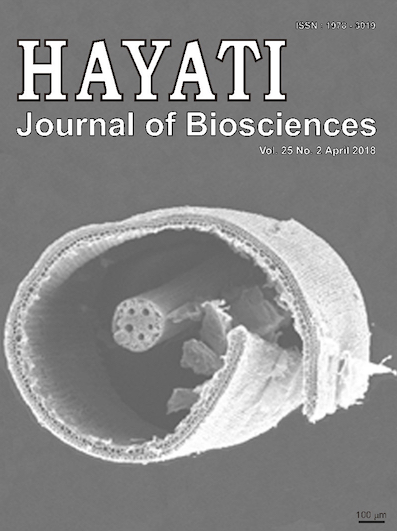Bacterial Communities in Aquatic Sediment from Bukit Duabelas Raintforest and Oil Palm Plantation at Sumatra Indonesia
Abstract
The diversity of bacterial communities in aquatic sediment of rainforest and oil palm plantation at Sumatra was studied using pyrosequencing of 16S rRNA gene and common biodiversity indices. Phylogenetic approach was used for revealing the community shift of bacterial phyla and genera in both areas. Ecological approach used soil pH, total Carbon (TC), total Nitrogen (TN), available Phosphorus (AP) measurement and bacterial diversity with Shanon and Simpson indices, and bacterial richness with Chao1-ACE indices and OTUs. Bacterial diversity and richness in aquatic sediment of forest area was higher than that ones in oil palm plantation area, although their pH, TC, and TN in both areas were not different significantly. The majority of sequences related to Proteobacteria (34.85%), Acidobacteria (32.67%), Nitrospirae (6.86%), Chloroflexi (4.31%), and Actinobacteria (4.02%) were from forest; whereas those related to Acidobacteria (46.10%), Proteobacteria (25.86%), Nitrospirae (9.20%), Chloroflexi (4.99%), and Actinobacteria (2.34%) invented from oil palm plantation. The genera of Alphaproteobacteria and Betaproteobacteria dominated in genera phylotype of bacterial 16S rRNA phylogenetic revealed both aquatic sediment of forest and oil palm plantation. The most genera in the phylogenetic tree from aquatic sediment of both areas was Burkholderia. The bacterial community shift in aquatic sediment of forest transformation indicated higher bacterial diversity index, richness index, some of phyla and genera in aquatic sediment from forest than from oil palm plantation.Downloads
HAYATI J Biosci is an open access journal and the article's license is CC-BY-NC. This license lets others distribute, remix, tweak, and build upon author's work, as long as they credit the original creation. Authors retain copyright and grant the journal/publisher non exclusive publishing rights with the work simultaneously licensed under a https://creativecommons.org/


















.png) IPB University
IPB University Department of Biology
Department of Biology The Indonesian Biological Society
The Indonesian Biological Society 

